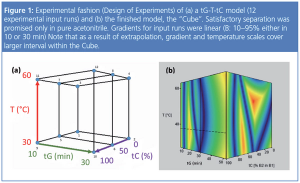Articles by Arnold Zoldhegyi

High performance liquid chromatography (HPLC) is a widely used and well-established technique, routinely employed by thousands of analytical scientists worldwide. Nonetheless, certain challenges—arising from the complex interplay of multiple factors affecting peak retention and separation—persist. In this context, multidimensional modeling approaches can provide valuable support.

Presenting a novel chromatographic modelling method to establish QbD-compliant comparative testing of eluent design spaces.

With the era of new complex drug products there is an increasing demand on multivariate modelling tools to integrate robust analytical method design, facilitate efficient and science-based change management, and improve communication between regulators and industry. Mechanistic models provide several advantages in terms of modelling efficiency, versatility, and high predictive power. The following case study will demonstrate a robust method design for industrial Cannabis sativa.

Food analysis is often handled less thoroughly than pharmaceutical analysis because of the smaller life-threatening risk expected from foodstuffs. However, food analysis is still a major focus for chromatographers from a scientific and an analytical point of view. Adoption of modern “in‑silico” techniques, such as chromatographic modelling, offer analysts new possibilities for method development.







